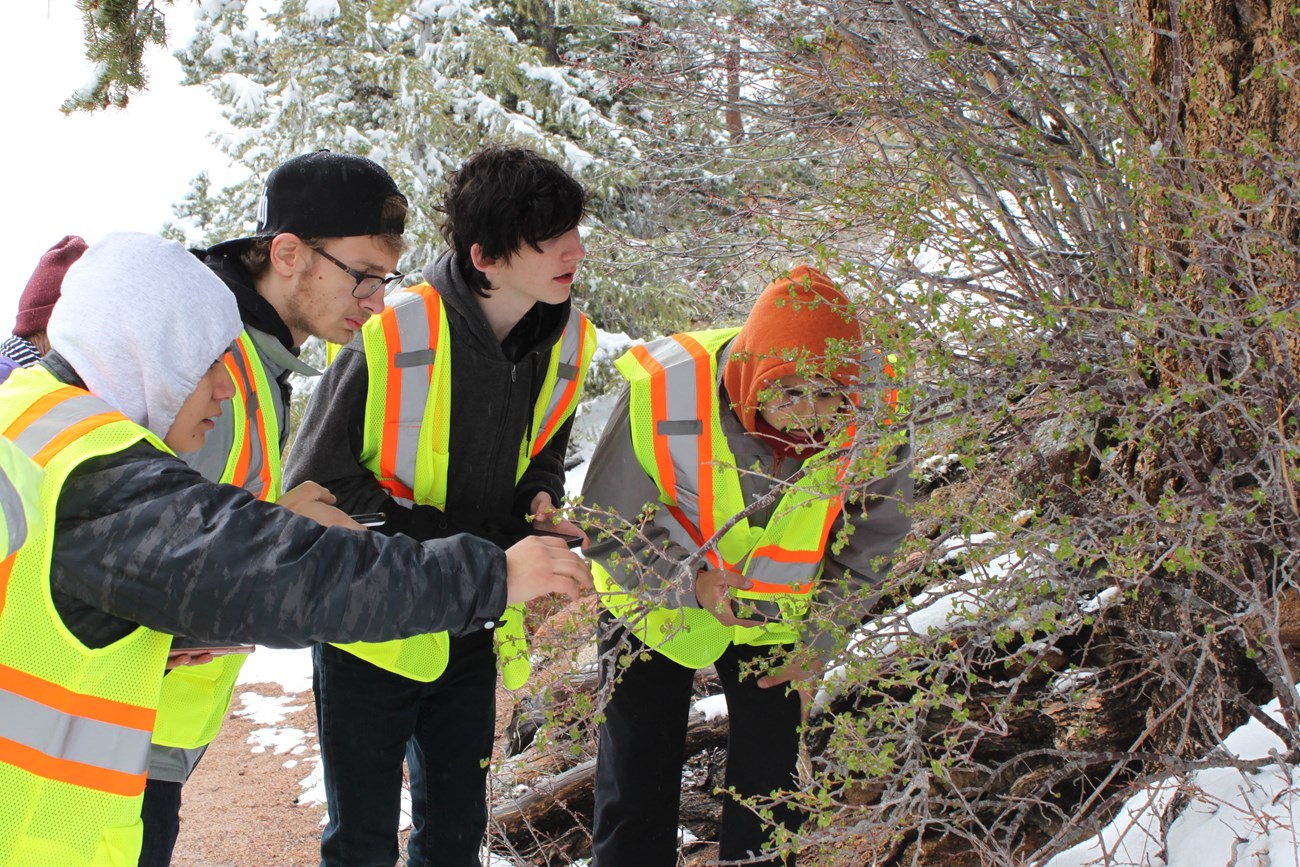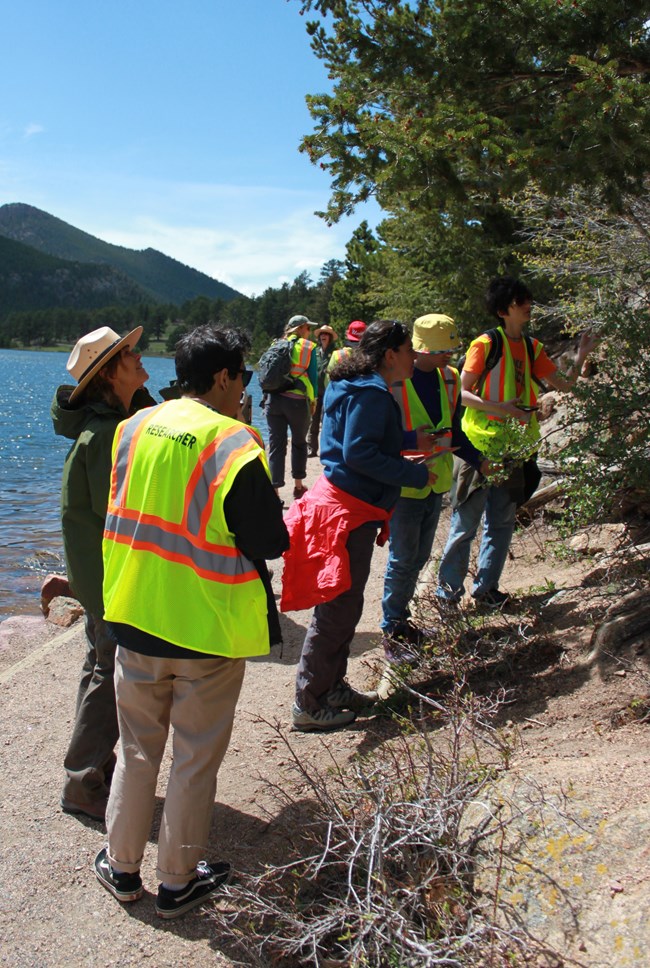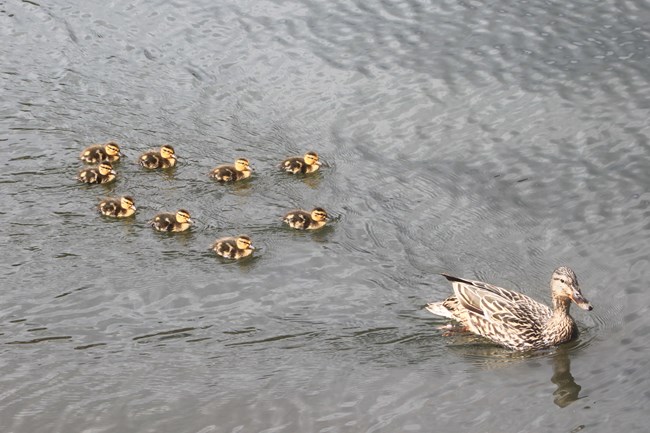Last updated: July 15, 2019
Article
Student Citizen Scientists Explore Phenology
How are plants and animals at Rocky Mountain National Park responding as the environment changes? Students from Estes Park’s Eagle Rock School are participating in Rocky Mountain National Park’s Lily Lake Phenology project to learn more about some of the species found at the lake, help the park collect field data as citizen scientists, and become inspired by the plant and animal species they encounter.

NPS / Carissa Turner
First Day in the Field
The students’ began their field season at the lake in late May with temperatures still in the 40’s, overcast clouds blocking the view of Long’s Peak, and the snow hiding most signs of spring underneath it. The willow shrub, limber pine tree, and aspen tree still had their winter look with no leaf buds, no new needles and no catkins. Despite the lake’s frosty mood, the students were still able to observe a few signs of spring with the wax currant shrub’s new leaf buds and small sporadic open leaves, pasqueflowers poking through the snow, hummingbirds, and a young moose down from higher elevations, where they typically spend the winter in the park.
Eagle Rock School of Estes Park, Colorado is a not-for-profit full-scholarship residential high school that serves adolescents who have not experienced success in traditional academic programs, have few positive options available to them, and are interested in taking control of the lives and education. The curriculum emphasizes personal growth, service and high expectations through active, interactive, interdisciplinary, and project-based experiential learning. In 2019, the school created a 5-week course during their summer trimester that focuses on the park’s Lily Lake Phenology Walk. Eagle Rock School’s Phenology of Lily Lake course concentrates on learning more about citizen science, phenology, climate change, and the lake’s species and ecosystems.
Citizen science is scientific research that involves the participation of the public assisting professional scientists. This assistance is typically in the form of helping with data collection and/or data analysis. An increasingly popular use of citizen science is with the collection of phenological data. Phenology is the study of the timing of biological life cycle events (like migratory birds flying north in spring, wildflowers blooming in summer and leaves changing color in fall) and how climate and habitat influence these events. Lately, phenology has been a topic of much interest as we contemplate how species will react to a changing climate.

NPS / Vishva Nalamalapu
Field Season Midpoint
After just a few weeks and the class half over, both the students and the species at Lily Lake looked to be in full production by the first week of June. The willow was displaying leaf buds, open leaves and catkins while the wax currant was full with mostly open leaves and open flowers. The limber pine had young needles and pollen cones releasing pollen while the aspen had fully open leaves after bypassing the production of catkins. The students were also excited to hear chorus frogs and to be finally observing the tiger salamanders in their wild alien-looking aquatic phase in the shallow ends of the lake. This week also involved the students meeting Rocky Mountain National Park’s Leadership Team at Lily Lake to guide them through the observation and data collection process, share what they had learned with the class and their career goals, and ask the leadership team members about their own educational and career experiences.
The Lily Lake Phenology Walk is a citizen science-based activity that allows visitors to Rocky Mountain National Park an opportunity to collect scientific data by answering simple questions related to the timing of biological events. Using just a smartphone or tablet, visitors collect data while walking the 0.8-mile trail that circles the lake. The questions involve observing what a number of individual plant species (willow shrub, wax currant shrub, limber pine tree, and aspen tree) are displaying, observing whether certain wildflower species are blooming, and listening for certain sounds related to phenological events (like chorus frogs making their mating calls, song birds singing, and elk bugling). Additionally, the walk involves observing the level of snow cover on Long’s Peak, and identifying the presence of certain types of wildlife, which are typically only seen at the lake at certain points of the year (like hummingbirds, tiger salamanders, and ducklings).

NPS / Todd Cornwell
Last Day in the Field
On their final day in the field in the middle of June and after just five weeks, the students were able to reflect on just how different the lake looked compared to when they started. All the shrubs and trees were bright green with leaves or new needles and displayed flowers, cones or catkins needed for reproduction. The pasqueflowers, which were just starting to emerge when the class started, were on their way out and seen off by blooming wild iris and tall chiming-bells. As a final goodbye, a mother mallard brought her brood of nine ducklings out to parade as the students finished up their last data collection stop.
By developing scientific observation & identification skills, focusing on science communication, keeping nature journals, and sketching infographics and artwork, the students are helping the park in its quest to understand our changing environment. By also concentrating on the ability to explain the project and citizen science to other visitors at the lake, the students are also helping the park by spreading awareness of the need for a further understanding of our changing natural world and awareness of what is possible through citizen science.
Interested in becoming a Citizen Scientist?
Both one-time and frequent visitors of all ages to Lily Lake are encouraged to participate in the project by going to go.nps.gov/LilyLakeScience with the smartphone or tablet, which contains links to the questions page and to the data previously submitted. Adding only 20 minutes to your hike around the lake, you can collect data that helps determine if there are shifts in the phenology of the park’s species and helps park managers make more informed management decisions related to our changing natural environment.
